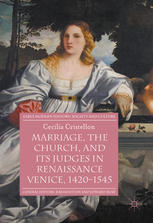

Most ebook files are in PDF format, so you can easily read them using various software such as Foxit Reader or directly on the Google Chrome browser.
Some ebook files are released by publishers in other formats such as .awz, .mobi, .epub, .fb2, etc. You may need to install specific software to read these formats on mobile/PC, such as Calibre.
Please read the tutorial at this link: https://ebookbell.com/faq
We offer FREE conversion to the popular formats you request; however, this may take some time. Therefore, right after payment, please email us, and we will try to provide the service as quickly as possible.
For some exceptional file formats or broken links (if any), please refrain from opening any disputes. Instead, email us first, and we will try to assist within a maximum of 6 hours.
EbookBell Team

0.0
0 reviewsThis book investigates the actions of marriage tribunals by analyzing the richest source of marriage suits extant in Italy, those of the Venetian ecclesiastical tribunal, between 1420 and the opening of the Council of Trent. It offers a strongly representative overview of the changes the Council introduced to centuries-old marriage practices, relegating it to the realm of marginality and deviance and nearly erasing the memory of it altogether. From the eleventh century onward, the Church assured itself of a jurisdictional monopoly over the matter of marriage, operating both in concert and in conflict with secular authorities by virtue of marriage’s civil consequences, the first of which regarded the legitimacy of children. Secular tribunals were responsible for patrimonial matters between spouses, though the Church at times inserted itself into these matters either directly, by substituting itself for the secular authority, or indirectly, by influencing Rulings through their own sentences. Lay magistratures, for their part, somewhat eroded the authority of ecclesiastical tribunals by continuing to exercise autonomous jurisdiction over marriage, especially regarding separation and crimes strictly connected to the nuptial bond and its definition, including adultery, bigamy, and rape.